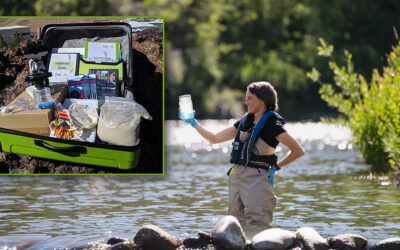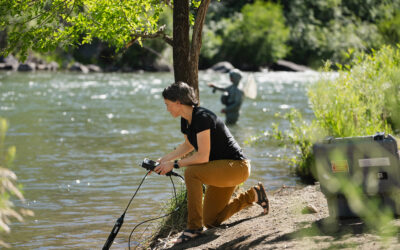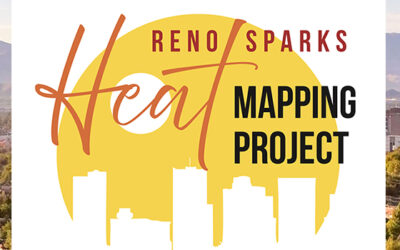Scientists teamed up with nonprofit Clean Up the Lake to collect and analyze litter found on the bottom of Lake Tahoe
Reno, Nev. (Jan. 2, 2024) – Plastic litter is a growing problem around the world, and new research shows that the bottom of Lake Tahoe is no exception. In one of the first studies to utilize scuba divers to collect litter from a lakebed, 673 plastic items were counted from just a small fraction of the lake.
In the study, published in the November issue of the journal Applied Spectroscopy, researchers from DRI and the UC Davis Tahoe Environmental Research Center teamed up with the nonprofit Clean Up the Lake to take a close look at the litter. First, scientists broke it down into categories based on use (such as food containers and water bottles), followed by the chemical composition of the plastic. The knowledge gained can help scientists better understand the source of large pieces of litter in the lake, as well as whether they’re a significant source of microplastics as larger pieces break down and degrade. Previous research found that the waters of Lake Tahoe contain high levels of microplastics, defined as plastics smaller than a pencil eraser.
“There’s very little work on submerged plastic litter in lakes,” said Monica Arienzo, Ph.D., associate research professor of hydrology at DRI and one of the study’s lead authors. “And I think that’s a real issue, because when we think about how plastics may be moving in freshwater systems, there’s a good chance that they’ll end up in a lake.”
To collect the litter, research divers swam transects along the lakebed near Lake Tahoe Nevada State Park and Zephyr Cove, covering 9.3 kilometers. They found an average of 83 pieces of plastic litter per kilometer, with the lakebed near Hidden Beach and South Sand Harbor showing significantly more (140 items/km and 124 items/km, respectively). No stretches of the lakebed surveyed were free of plastic litter.
The most common plastic litter categories were food containers, bottles, plastic bags, and toys, along with many items that couldn’t be categorized.
“There’s a lot of education we can do, as well as continuing to work on reducing the use of those plastics,” Arienzo says. “Because we have to start thinking about turning that plastic pipe off.”
Arienzo and co-author Julia Davidson, then an undergraduate student working in Arienzo’s lab, also identified the types of plastic that made up 516 of the litter samples. Using an instrument that uses infrared light to fingerprint and identify the material, they found that the six most common plastics were polyvinyl chloride (PVC), polystyrene, polyester/polyethylene terephthalate, polyethylene, polypropylene, and polyamide. Collecting this information can contribute to Arienzo’s ongoing microplastics research in the region, helping to identify the sources of the small plastic fragments.
“When we study microplastics, we only have the chemical information, or the plastic type,” Davidson says. “We don’t know where it came from—a plastic bag, toy, or otherwise— because it’s just a tiny piece of plastic. But now we can use this litter data to point to the dominant types of plastics and compare them to microplastic data.”
The study can help inform efforts by Tahoe-area communities to address plastic litter, such as South Lake Tahoe’s 2022 ban on single-use plastic bottles and Truckee’s ban on single-use food containers. The research also highlights ways that scientists can work with nonprofits to collect data that can address local environmental concerns.
“I think one of the things that’s really cool about this project is the collaboration between DRI, Clean Up the Lake, and UC Davis at Tahoe,” Arienzo says. “It demonstrates the power of bringing together a nonprofit that really wants to clean up Tahoe, while collecting data in the process that can help answer scientific questions.”
###
More information: The full study, Polymer Characterization of Submerged Plastic Litter from Lake Tahoe, is available from Applied Spectroscopy at https://doi.org/10.1177/00037028231201174
Study authors include: Julia Davidson (DRI), Monica Arienzo (DRI), Zoe Harrold (Clear Horizons Consulting), Colin West (Clean Up the Lake), Erick R. Bandala (DRI), Sadye Easler (Clean Up the Lake), Katie Senft (UC Davis Tahoe Environmental Research Center)
Photo Credit: Brian Yurasits on Unsplash
###
About DRI
The Desert Research Institute (DRI) is a recognized world leader in basic and applied environmental research. Committed to scientific excellence and integrity, DRI faculty, students who work alongside them, and staff have developed scientific knowledge and innovative technologies in research projects around the globe. Since 1959, DRI’s research has advanced scientific knowledge on topics ranging from humans’ impact on the environment to the environment’s impact on humans. DRI’s impactful science and inspiring solutions support Nevada’s diverse economy, provide science-based educational opportunities, and inform policymakers, business leaders, and community members. With campuses in Las Vegas and Reno, DRI serves as the non-profit research arm of the Nevada System of Higher Education. For more information, please visit www.dri.edu.
About Clean Up The Lake
Clean Up The Lake is a nonprofit organization whose mission is to activate local communities to take action to protect their environment both above and below the surface, starting in Lake Tahoe. The organization has completed its flagship project of a 72 mile SCUBA cleanup of Lake Tahoe’s entire circumference in 2022 and has gone on to clean up over 69,000 pounds of litter in the Sierra region, primarily from beneath the surface of Alpine Lakes. The non profit has expanded from submerged litter cleanups to include aquatic invasive species surveillance and education, collaborations to bring litter-art sculptures and stewardship messaging to communities they work in and also a variety of youth programs for our future generations. To learn more about the organization or to donate, please visit cleanupthelake.org.
Media Contacts:
DRI
Elyse DeFranco
Science Writer
elyse.defranco@dri.edu
Clean Up The Lake:
Colin West
+1 (530) 562 7131
colin@cleanupthelake.org


